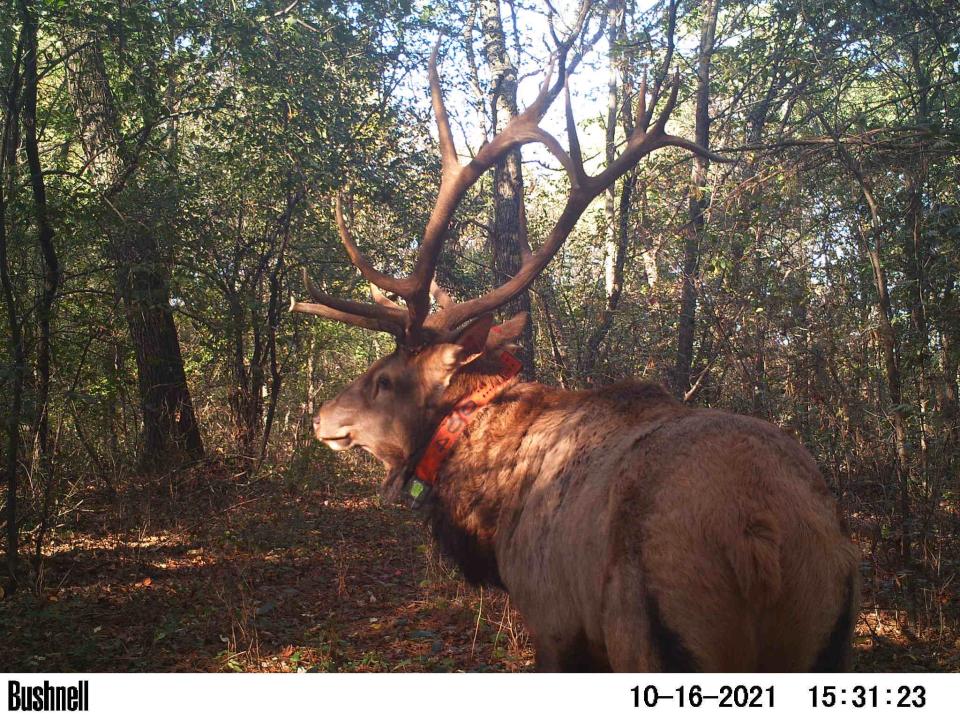Wandering bull elk hit by semi, bringing his journey to a close in Illinois
MADISON – The fantastic voyage of a bull elk from the Black River State Forest herd came to an end this week, southwest of Chicago.
Bull elk No. 357 was struck and killed by a semi sometime overnight and was discovered Wednesday morning, said Eric Lobner, director of the Department of Natural Resource's wildlife management program, bringing his long trek to an end near the intersection of Interstates 80 and 55.
Though the elk wasn't wearing a tracking collar, he was identified by a tag bearing a number, Lobner said.

The elk seemed to be heading toward Indiana this week and had been spotted a few times by Illinois residents on trail cameras. He was last seen in Newark, Illinois, Lobner said.
Starting in September tips came to the DNR through a wildlife observation database about the wandering elk.
It had quite a trip.
The elk started east through the woods to Marathon County, hung out in Wausau, took a quick detour north into Taylor County, headed south again to Wisconsin Rapids and Columbia County and then was spotted near Madison, covering hundreds of miles traveled.
Lobner said the elk's journey, while unusual for its distance outside the herd, wasn't too out of the ordinary for a male, especially during the breeding season.
"He got himself kind of a little bit far from the rest of the herd, and most likely he just was continuing to search for other (elk) and didn't know which direction to go to get himself back to where the herd was," Lobner said.
More: A lonely bull elk has traveled hundreds of miles across Wisconsin searching for love
"It's kind of interesting in a way because I was looking at a map and I was starting to question, was it closer to Kentucky, which is where this animal's genetics originally came from? But I'm certain there was no genetic pull that would have taken him in that direction."
Elk, a species native to Wisconsin, were reintroduced in Wisconsin in 1995. Sourced from Michigan, 25 elk were brought into the state. They settled around Clam Lake, where the population has grown through conservation efforts and the introduction of 150 more elk between 2015 and 2019 to increase the herd size and its genetic diversity.
Some of those 150, from Kentucky, were reintroduced to the Black River State Forest to start a second herd in central Wisconsin in 2015, with 23 coming to the area in 2015 and 50 more in 2016.
The statewide elk population currently sits around 550 between cows, bulls and calves between the two herds.
This year's milestone of more than 500 animals is likely the first time in at least 150 years the state has had this many wild elk.
The state's northern elk herd occupies a range of about 400 square miles. The primary habitat used by the elk consists of aspen and pine forests interspersed with forest openings, as well as lowland conifers in the winter.
Lobner said typically, when bulls wander, they end up coming back to their home. It's unclear if this elk would have made his way back, but he did get to make an impression on residents all along his route, an exposure that many people wouldn't have typically had.
"This is a disappointing day in a way, because he certainly he did have a celebrity status," Lobner said.
Journal Sentinel reporter Drew Dawson contributed.
Laura Schulte can be reached at leschulte@jrn.com and on X at @SchulteLaura.
This article originally appeared on Milwaukee Journal Sentinel: Wandering Wisconsin elk hit by semi, ending his journey in Illinois

